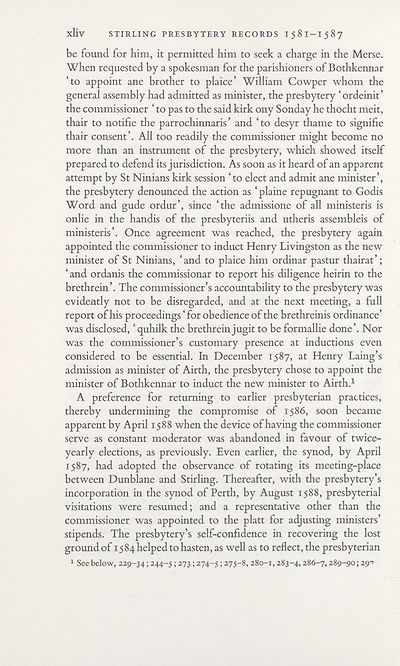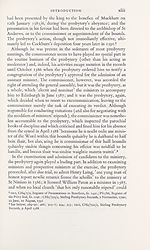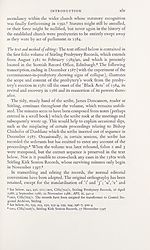Series 4 > Stirling Presbytery Records 1581-1587
(49) Page xliv
Download files
Complete book:
Individual page:
Thumbnail gallery: Grid view | List view

xliv STIRLING PRESBYTERY RECORDS I581-I587
be found for him, it permitted him to seek a charge in the Merse.
When requested by a spokesman for the parishioners of Bothkennar
‘to appoint ane brother to plaice’ William Cowper whom the
general assembly had admitted as minister, the presbytery ‘ordeinit’
the commissioner ‘ to pas to the said kirk ony Sonday he thocht meit,
thair to notifie the parrochinnaris’ and ‘to desyr thame to signifie
thair consent’. All too readily the commissioner might become no
more than an instrument of the presbytery, which showed itself
prepared to defend its jurisdiction. As soon as it heard of an apparent
attempt by St Ninians kirk session ‘to elect and admit ane minister’,
the presbytery denounced the action as ‘plaine repugnant to Godis
Word and gude ordur’, since ‘the admissione of all ministeris is
onlie in the handis of the presbyteriis and utheris assembleis of
ministeris’. Once agreement was reached, the presbytery again
appointed the commissioner to induct Henry Livingston as the new
minister of St Ninians, ‘and to plaice him ordinar pastur thairat’;
‘and ordanis the commissionar to report his diligence heirin to the
brethrein’. The commissioner’s accountability to the presbytery was
evidently not to be disregarded, and at the next meeting, a full
report of his proceedings ‘ for obedience of the brethreinis ordinance’
was disclosed, ‘quhilk the brethrein jugit to be formallie done’. Nor
was the commissioner’s customary presence at inductions even
considered to be essential. In December 1587, at Henry Laing’s
admission as minister of Airth, the presbytery chose to appoint the
minister of Bothkennar to induct the new minister to Airth.1
A preference for returning to earlier presbyterian practices,
thereby undermining the compromise of 1586, soon became
apparent by April 1588 when the device of having the commissioner
serve as constant moderator was abandoned in favour of twice-
yearly elections, as previously. Even earlier, the synod, by April
1587, had adopted the observance of rotating its meeting-place
between Dunblane and Stirling. Thereafter, with the presbytery’s
incorporation in the synod of Perth, by August 1588, presbyterial
visitations were resumed; and a representative other than the
commissioner was appointed to the platt for adjusting ministers’
stipends. The presbytery’s self-confidence in recovering the lost
ground of 15 84 helped to hasten, as well as to reflect, the presbyterian
1 See below, 229-34; 244-5; 273 ; 274-5; 275-8,280-1,283-4,286-7,289-90; 29^
be found for him, it permitted him to seek a charge in the Merse.
When requested by a spokesman for the parishioners of Bothkennar
‘to appoint ane brother to plaice’ William Cowper whom the
general assembly had admitted as minister, the presbytery ‘ordeinit’
the commissioner ‘ to pas to the said kirk ony Sonday he thocht meit,
thair to notifie the parrochinnaris’ and ‘to desyr thame to signifie
thair consent’. All too readily the commissioner might become no
more than an instrument of the presbytery, which showed itself
prepared to defend its jurisdiction. As soon as it heard of an apparent
attempt by St Ninians kirk session ‘to elect and admit ane minister’,
the presbytery denounced the action as ‘plaine repugnant to Godis
Word and gude ordur’, since ‘the admissione of all ministeris is
onlie in the handis of the presbyteriis and utheris assembleis of
ministeris’. Once agreement was reached, the presbytery again
appointed the commissioner to induct Henry Livingston as the new
minister of St Ninians, ‘and to plaice him ordinar pastur thairat’;
‘and ordanis the commissionar to report his diligence heirin to the
brethrein’. The commissioner’s accountability to the presbytery was
evidently not to be disregarded, and at the next meeting, a full
report of his proceedings ‘ for obedience of the brethreinis ordinance’
was disclosed, ‘quhilk the brethrein jugit to be formallie done’. Nor
was the commissioner’s customary presence at inductions even
considered to be essential. In December 1587, at Henry Laing’s
admission as minister of Airth, the presbytery chose to appoint the
minister of Bothkennar to induct the new minister to Airth.1
A preference for returning to earlier presbyterian practices,
thereby undermining the compromise of 1586, soon became
apparent by April 1588 when the device of having the commissioner
serve as constant moderator was abandoned in favour of twice-
yearly elections, as previously. Even earlier, the synod, by April
1587, had adopted the observance of rotating its meeting-place
between Dunblane and Stirling. Thereafter, with the presbytery’s
incorporation in the synod of Perth, by August 1588, presbyterial
visitations were resumed; and a representative other than the
commissioner was appointed to the platt for adjusting ministers’
stipends. The presbytery’s self-confidence in recovering the lost
ground of 15 84 helped to hasten, as well as to reflect, the presbyterian
1 See below, 229-34; 244-5; 273 ; 274-5; 275-8,280-1,283-4,286-7,289-90; 29^
Set display mode to:
![]() Universal Viewer |
Universal Viewer | ![]() Mirador |
Large image | Transcription
Mirador |
Large image | Transcription
Images and transcriptions on this page, including medium image downloads, may be used under the Creative Commons Attribution 4.0 International Licence unless otherwise stated. ![]()
| Scottish History Society volumes > Series 4 > Stirling Presbytery Records 1581-1587 > (49) Page xliv |
|---|
| Permanent URL | https://digital.nls.uk/126646743 |
|---|
| Description | Over 180 volumes, published by the Scottish History Society, containing original sources on Scotland's history and people. With a wide range of subjects, the books collectively cover all periods from the 12th to 20th centuries, and reflect changing trends in Scottish history. Sources are accompanied by scholarly interpretation, references and bibliographies. Volumes are usually published annually, and more digitised volumes will be added as they become available. |
|---|


